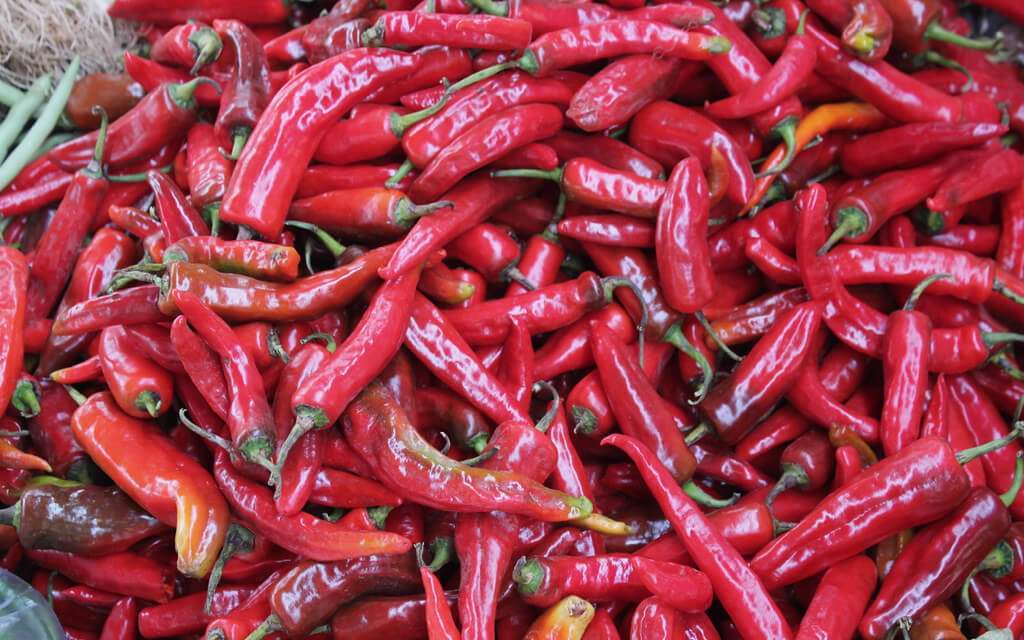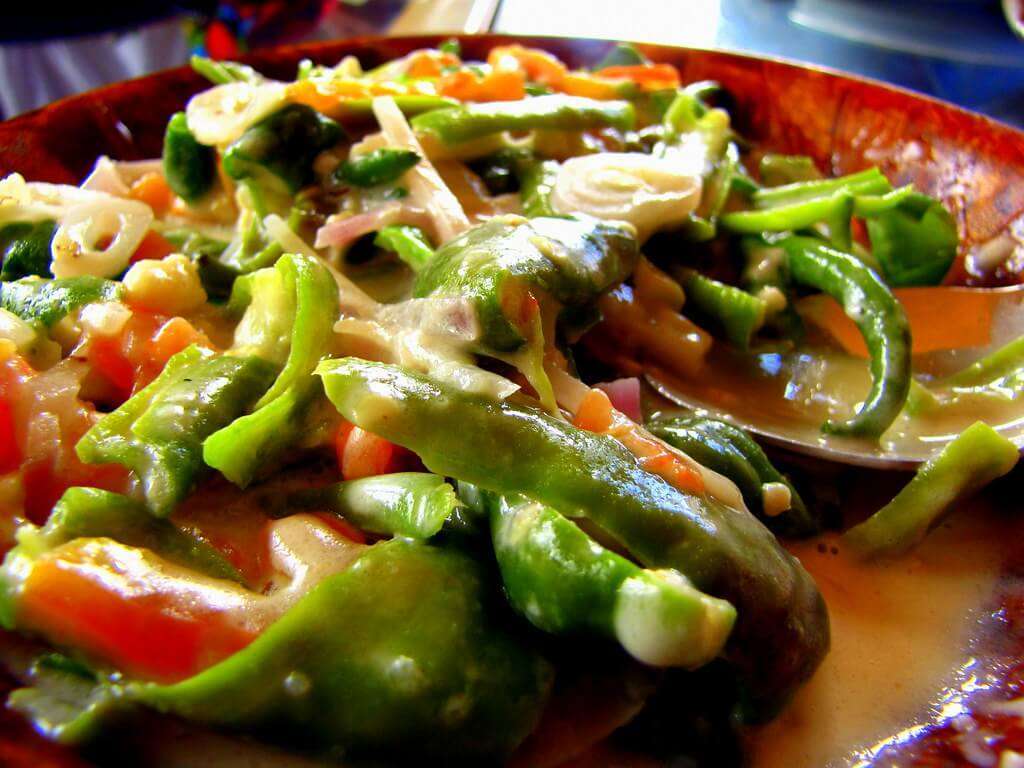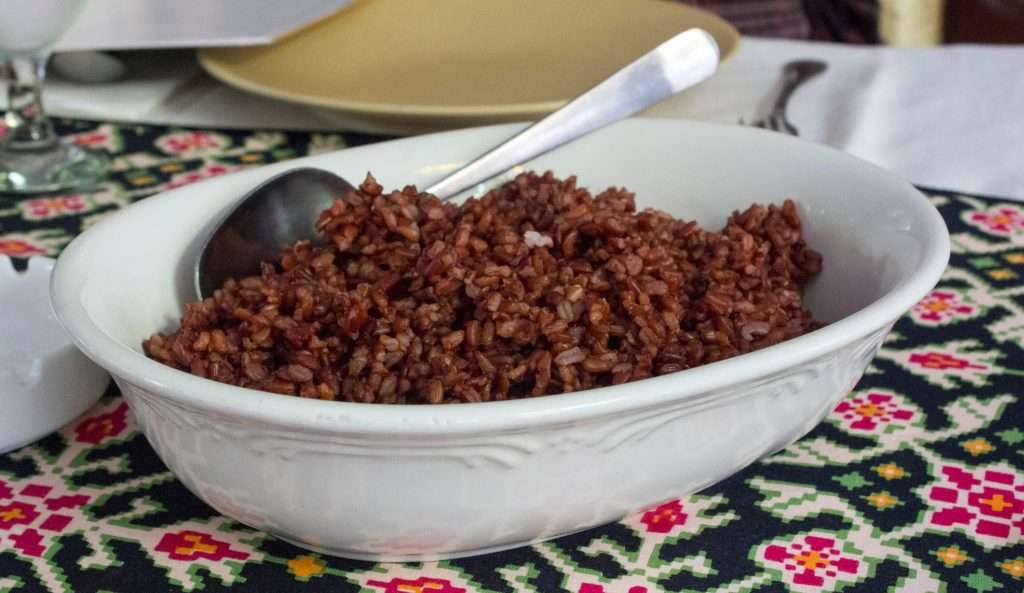Table of Contents
Starting with a culinary journey through the scenic mountain landscapes of Bhutan is as much about embracing the country’s vibrant culture as it is about discovering its unique foods and flavors from Bhutan. Bhutan’s cuisine is a feast for the senses, a spicy medley that reveals as much about its people’s way of life as it does about their taste buds. In this elaborate yet hot post, let’s savor the dishes that weave together the rich culinary traditions of this Himalayan kingdom’s gastronomic identity.
A Land Where Chillies Reign Supreme
In Bhutan, red chillies are more than just a spice; they are the heart and soul of the culinary scene, the vibrant red thread that binds the fabric of Bhutanese gastronomy. At local markets, heaps of fresh red chillies glisten like jewels, their fiery potential tucked away within their glossy skins. It’s a sight to behold, one that highlights the importance of this potent spice in Bhutanese food culture. From the smallest roadside stalls to the grandest festive feasts, chillies impart a life force that is both feared and revered.

Ema Datshi, the iconic Bhutanese dish, is a love letter to the country’s favorite spice. In every bubbling pot of this rich, cheesy stew, there is a story of Bhutan’s agrarian roots, a narrative of its climatic resilience. The locals have mastered the art of balancing the chillies’ heat with the creaminess of datshi, creating a dish that’s as complex as it is comforting. It’s a communal favorite, a staple that acts as a culinary handshake between the cook and those they feed. In every home and eatery, you’ll find Ema Datshi simmering on the stove, its aroma a warm welcome to any visitor.

Venturing through the local cuisine, you quickly realize that chilies are not just a seasoning but the very essence of Bhutanese cooking. They’re woven into the fabric of each meal, offering a heat that’s as integral to the dining experience as the prayer flags fluttering in the breeze. Whether it’s the sharp bite of a fresh chili or the smoky depth of a dried one, these peppers are a testament to the Bhutanese people’s love for flavors that are as bold and spirited as their national character.
Sustainable Food of the Mountains
The highlands of Bhutan are more than just a source of breathtaking scenery; they are the pantry of the nation. Here, amidst the crisp mountain air, crops like buckwheat and red rice flourish, their cultivation a proof of Bhutanese people’s harmony with their environment. The fields of the Paro Valley, awash with the unique hue of red rice, tell a tale of agricultural ingenuity—of a crop that’s adapted to thrive in the thin, cool air of the Himalayas.
Buckwheat, with its robust flavor and hearty texture, is the unsung hero of Bhutanese cuisine. The terraced fields of Bumthang are dotted with these resilient plants, their yields transformed into warm, nourishing pancakes and chewy noodles that carry with them the flavors of the land. These traditional foods are a bridge between the old and the new, a way for the Bhutanese to honor their ancestors’ wisdom while feeding the present’s appetite.

The beauty of Bhutanese staples lies in their simplicity and their ability to convey the essence of the mountains. Red rice, with its nutty undertones, serves as the perfect bed for the vibrant stews and curries that characterize the local fare. It’s a symbiotic relationship where the land provides for the people, and in return, the people sing the land’s praises through their culinary creations. The grains and crops grown in the high-altitude fields aren’t just the sustenance of the body; they’re the sustenance of the Bhutanese soul, a constant reminder of the nation’s connection to its rugged, majestic terrain.
The Simplicity of Bhutanese Foods
Simplicity is the cornerstone of Bhutanese cuisine, and this is no more evident than in the comforting embrace of suja, the butter tea that is a staple in every household. The ritual of preparing suja is as much a part of Bhutanese life as the tea itself, with the churning of butter and salt creating a frothy, hearty beverage that warms from within. It’s a simple drink with profound significance, offering sustenance and comfort during the long, cold winters.
In the communal Bhutanese culture, food is a social event, a reason to gather and share. The preparation of momo dumplings is a communal activity, with each family member taking part in stuffing and shaping these little parcels of joy. The act of making and enjoying momos is imbued with a sense of togetherness, reinforcing family bonds and communal ties. Jasha maroo, the spicy chicken stew, is similarly shared, its rich aroma filling homes and signifying the presence of loved ones gathered around the hearth.
As you sip on suja and share in the communal dining experience, you realize that the simplicity of these staples is deceptive. There is a depth of flavor and meaning in every cup of tea and every bite of food that speaks to the Bhutanese way of life—a life that values community, simplicity, and the joy of shared experiences. These staples are not just about sustenance; they are about sustaining a way of life that cherishes togetherness and the simple pleasures of a meal shared with others.
A Harmonious Blend of Flavors
The palette of Bhutanese cuisine is a harmonious blend of influences and indigenous practices. It is a canvas where the bold strokes of Indian spices meet the gentle shades of Tibetan simplicity, all against the backdrop of Bhutan’s rich, agricultural canvas. The result is a culinary identity that is distinctly Bhutanese yet echoes the familiar tones of its neighbors. This interplay of flavors is a testament to Bhutan’s historical ties and its geographic tapestry, bridging borders with each dish.
The indigenous herbs of Bhutan, like the tingly Sichuan pepper known locally as thingay, play a leading role in the culinary orchestra. They bring to the table a melody that is peculiar to this part of the world—a flavor that tingles and dances on the tongue, leaving behind a warm, spicy note. This is not just food; it’s an experience, an exploration of taste that echoes the natural vibrancy of Bhutan’s landscape and the spiritedness of its people.
Dried meats add an unexpected twist to the Bhutanese menu, introducing a savory depth that complements the country’s penchant for heat and spice. The preservation of meat is an age-old tradition, a clever adaptation to high-altitude living where the air is the perfect companion for curing. This practice is a nod to the resourcefulness of the Bhutanese and their ability to create a cuisine that is rich and varied, even within the limitations imposed by their environment.
Foraging and Farming and the Organic Essence
In a world where organic and sustainable living is often a choice, in Bhutan, it is a way of life. The country’s commitment to environmental conservation is reflected in every aspect of its culture, especially in its culinary practices. Those who are aware of the delicate balance of their ecosystem carefully gather wild mushrooms, herbs, and other edibles from Bhutan’s forests, which are a treasure trove of ingredients. This foraging is not just a means to an end but a profound connection to the earth, a respect for the bounty it offers.
The organic essence of Bhutanese cuisine is rooted in the belief that food should nourish not just the body but also the soul. The cheese that tops a steaming bowl of Ema Datshi comes from yaks that roam free in the highlands; their milk is a creamy testament to the purity of Bhutan’s pastures. The vegetables that add color and crunch to every dish are the products of organic farming methods that have been passed down through generations, ensuring that every ingredient is as natural as it is flavorful.
This commitment to organic farming is not just about the end product; it’s about the process—a sustainable cycle that respects the land and its inhabitants. It’s a philosophy that permeates every aspect of Bhutanese life, from the way crops are rotated to the natural composting methods used to enrich the soil. In Bhutan, to eat is to engage in an act of environmental stewardship, a gesture of gratitude to the land that sustains and nurtures.
Festivals and Feasts, Colors and Tastes
Festivals and feasts in Bhutan are a kaleidoscope of colors, tastes, and aromas that capture the jubilant spirit of the nation. These occasions are when Bhutanese culinary artistry shines brightest, a time when traditional recipes are passed from one generation to the next, a vibrant thread in the cultural fabric of the country. The Tsechu festivals, in particular, are a feast for the senses, where the communal joys of dance and music spill over into the realm of gastronomy, with special dishes prepared to mark the occasion.

During these festivals, the air is perfumed with the scent of hontay, the buckwheat dumplings filled with turnip greens or cheese, steamed to perfection, and shared among friends and family. Each bite is a taste of Bhutan’s agricultural heritage, a subtle reminder of the seasons and the land. The festivals also present an opportunity for Bhutanese people to showcase their culinary creativity, often incorporating seasonal and local ingredients in a grand celebration of harvest and community.
Losar, the Bhutanese New Year, sees homes bustling with the warmth of cooking fires as families prepare elaborate nine-course meals. Each dish is imbued with significance, symbolizing wishes for prosperity, health, and happiness in the year to come. From rich stews that promise nourishment to soups that are meant to warm the soul, the New Year’s feast is a profound expression of Bhutanese culture, an edible mosaic of the nation’s hopes and dreams.
Beyond the Spices where Emotions Brew
The narrative of Bhutanese cuisine would be incomplete without the mention of its sweets and brews, the delicate counterpoints to the robust flavors of its savory dishes. Bhutanese sweets are not overpowering in their sugariness but carry with them the subtle sweetness of natural ingredients like honey, which is drizzled over pancakes or stirred into butter tea to add a comforting sweetness. These treats often incorporate local fruits and grains, creating desserts that are both earthy and satisfying.

The brewing of ara, the local rice wine, is an art form steeped in tradition, a craft that embodies the Bhutanese reverence for the processes of nature. Ara is not just a drink; it’s a symbol of hospitality, often served warm with a dollop of butter, a gesture of welcome that is extended to guests in homes across the country. The brew’s warmth is not merely physical; it carries with it the warmth of Bhutanese kindness, a liquid embrace from the people who call this mountain kingdom home.
Conclusion
A journey through Bhutanese cuisine is an adventure that tantalizes the taste buds and touches the heart. Each dish is a chapter in the country’s rich narrative, and each flavor is a verse in its storied past and vibrant present. Dining in Bhutan is not a passive act; it’s a participatory experience that invites you into the fold of Bhutanese life, offering insights into the country’s traditions, values, and aspirations.
Immersing oneself in the Bhutanese culinary landscape is to discover that the country’s true flavor is inseparable from its reverence for nature, its communal values, and the unbridled joy of its people. To dine in Bhutan is to absorb more than the flavors on your plate; it’s to partake in a culture that is as deep and complex as the dishes that have been passed down through generations. The food of Bhutan is a testament to the country’s heart, an edible invitation to explore a land where every meal is a celebration, every flavor an adventure, and every dining experience a step closer to understanding the soul of this unique Himalayan kingdom.


